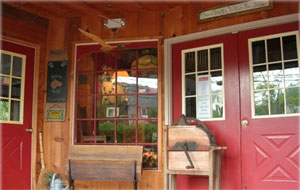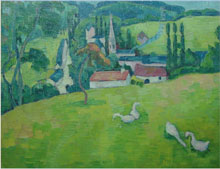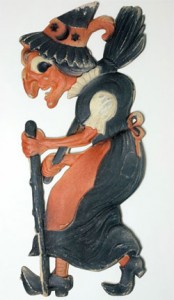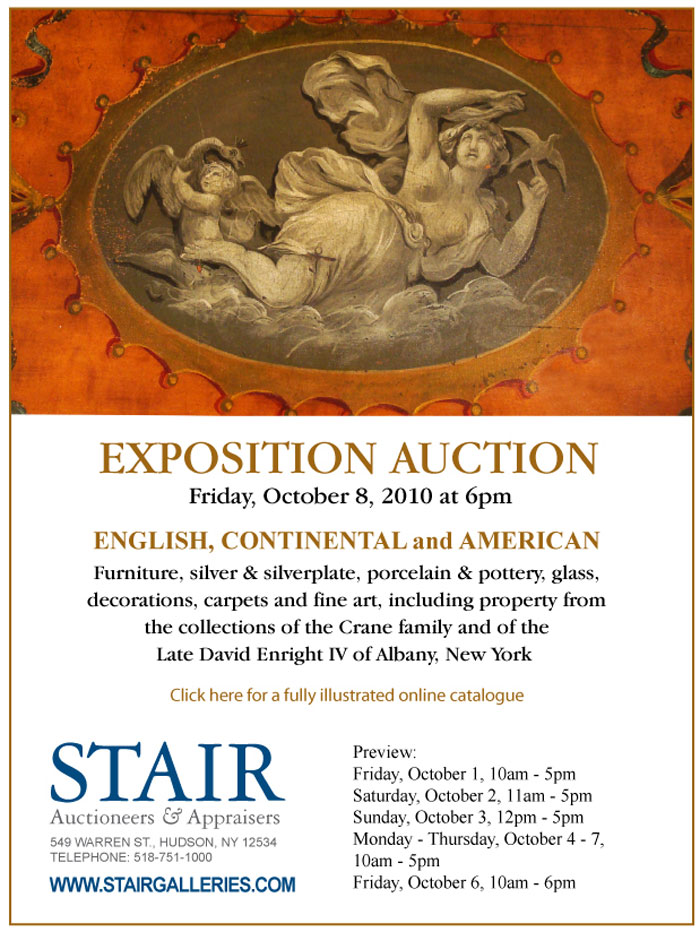Articles by admin
The Art of Picking – Episode 7 HD
Tuesday, October 5th, 2010Reyne Haines stops by to talk to stylist Suzy Smith about repurposing antiques. Repurposing is the reinvention of an antique used for one purpose into something used in a different way. Suzy has examples of beautifully repurposed objects and some tips for beginners interested in repurposing fabulous finds for themselves.
Reyne Guage – History of Halloween by Reyne Haines
Monday, October 4th, 2010
You might find it hard to believe that Halloween is not another “Hallmark” holiday made to create millions of dollars in commercial candy, card and costume sales.
Also, Halloween wasn’t founded in America. The Irish and the Scottish immigrants carried their versions of the tradition to North America in the nineteenth century. Soon to follow would be Canada, Ireland, Puerto Rico and the United Kingdom.
Halloween was originally called “Samhain” which was the name of an ancient Celtic festival that celebrated the end of the harvest season and the preparation of winter.
It was believed that on October 31st, the worlds of the living and the dead would cross and the dead would come back to life and spread sickness to the living and damage their crops. During the festival, people wore masks to keep the evil spirits at bay.
Fast forward to the 20th century where the art of “trick or treating” came to play during Halloween. Children in costumes knocked on doors asking the homeowner that simple question; “Trick or Treat?” The trick part happened to those who did not answer the door, or did with no treats. Tricks played by kids in America often involved egging someone’s home, or wrapping their yard in toilet paper. In the United Kingdom, the police often been called out because of the severity of the “tricks” the children play. The term “Trick or Treat” first appeared in print in 1934.
In states such as Iowa, Ohio and Massachusetts, Halloween is also known as Beggars Night because children go door to door begging for treats.
The act of dressing up and begging door to door actually extends as far back as the Middle Ages when the poor would go knocking on doors on Hallowmas (November 1st). They would receive food in return for prayers for the dead on All Souls Day (November 2nd).
Halloween was also known as “All Hallows Eve.” It was one of four, and the most powerful, holy days throughout the year when spirits could walk the earth and communicate with the living.
Before the commercial world joined in, children would beg door to door for treats, but the treats were not wrapped sweets like we know today. They would receive nuts and homemade candies.
Today, the Halloween capital of the world is Anoka, Minnesota. In 1920, they were the first city to hold a Halloween celebration in effort to prevent kids from pulling pranks around town. The town put together a parade to keep the kids busy and the kids that participated in the parade were rewarded with candy and popcorn. Since that time, the city has continued the annual parade and festivities, with the exception of 1942 and 1943 due to the war.
On a final note, Halloween is the 2nd largest commercial holiday in the US. Surprisingly it beats out Valentine’s Day with $6.9 billion dollars in commercials sales (and growing) each year.
Stair Auctioneers & Appraisers
Friday, October 1st, 2010Sotheby’s Contemporary Art – Arab & Iranian
Thursday, September 30th, 2010Sotheby’s – Fine Watches Auction
Thursday, September 30th, 2010Antiques in Historic Skippack Village
Thursday, September 30th, 2010 Just outside of Philadelphia, farm country rolls away to the north and west. Small historic villages like Skippack, which lies between Blue Bell and Collegeville, have provided town life for rural eastern Pennsylvania communities for over a hundred years. Skippack is still farmland; drive away from the main road in either direction and you’ll find yourself surrounded by corn and vales of pretty red cows. But, the relentless march of new housing is also in evidence, so for every working farm, old stone granary, or dilapidated barn you see from the road, you’ll also find new cul-de-sacs occupied by young families and Philadelphia commuters.
Just outside of Philadelphia, farm country rolls away to the north and west. Small historic villages like Skippack, which lies between Blue Bell and Collegeville, have provided town life for rural eastern Pennsylvania communities for over a hundred years. Skippack is still farmland; drive away from the main road in either direction and you’ll find yourself surrounded by corn and vales of pretty red cows. But, the relentless march of new housing is also in evidence, so for every working farm, old stone granary, or dilapidated barn you see from the road, you’ll also find new cul-de-sacs occupied by young families and Philadelphia commuters.
Like the best antiques destinations, Skippack is a perfect combination of the cherished old and the whimsical new. Between the antique shops (and there are plenty of them), you’ll find no lack of craft stores, shops selling garden and interior decorations, and lovely little street side cafes where those out for an autumn stroll can enjoy a cinnamon latte and rest their feet for a while.
If you drive down Skippack Pike (route 73) from Philadelphia toward Skippack you’ll find yourself passing first through the tiny village of Cedars. The distinguishing edifice in Cedars is the Cedar’s Antiques Emporium, a beautiful converted old barn (the restored barn alone is worth a look) with a crowing rooster painted on the side.
The emporium is a co-op which opened recently and is still in search of dealers. Case and booth rentals are available (call 610-584-1885 for details—no crafts) but the space appears to be filling quickly. The established dealers offer books, artwork, nautical items and furniture. One piece I had a hard time walking away from: an optometrist’s desk. It’s something like a roll-top secretary but flatter, since it’s designed not for work but to display pairs of glasses. I was charmed.
Keep driving through Cedars and you’ll reach the intersection of Skippack pike and Store Road. Here you can find a place to leave the car behind (there are plenty) and stroll. There are several worthy antiques shops here including Snyder Antiques and Remains to Be Seen, a friendly cluttered little place with odd hours. But two of these in particular are not to be missed, for different reasons.
First: Green Wolf’s Village Barn. The name is poetic, and the store is one of the most pleasant antique shops I’ve entered in years. Owned by Harry and Sylvia Wolf, the shop occupies an airy and beautifully lit barn-like space with a woodworking studio below and loft above. The barn is filled floor to ceiling with Rosebud-style sleds, farmhouse chairs, And Sylvia’s collection of antique washing machines (she calls them “gifts from loving husbands”). A back room displays furniture built from the wood of old barns and bookshelves made from the pipes from an antique pipe organ. The Cardinal Hollow Winery leases space in the building for a tasting room—you walk past the old farm supplies to get to where the wine is.
The second shop of note in Skippack is almost an institution here. It’s called Thorpe Antiques, and it’s designed less for casual strollers and more for people who are serious about antiques. If you love old things, love being left alone among old things in quiet old rooms in old buildings, and if you like ticking grandfather clocks and friendly cats—which I know I do—this is your place to browse. The store reminded me of my grandparents’ house (as good antiques shops often do). Thorpe’s specializes in clock repair, but Thorpe senior, known as the Doll Doctor, made a name for himself in doll triage and doll-sized furniture. His son clarifies the distinction between himself and his father, but also seems to know a thing or two about antique dolls and toys, which are displayed in a separate room from the furniture and clocks.
If you’re looking for specific items, come to Skippack village for country antiques, farm implements, farmhouse furniture and antique hunting supplies, like guns and decoys. Art is a notable item here as well—Currier and Ives prints, Victoriana, and nautical sketches abound. Most antiques in the village appear local to Pennsylvania and the Philadelphia area, so you may find tea tables and Windsor chairs if you’re lucky. But it’s also worth a trip to Skippack just to roam past the charming store fronts, watch the leaves turn and feel the October chill in the air.
By Erin Sweeney
for Antiques.com
Sotheby’s Contemporary Art Auction
Thursday, September 30th, 2010Coker’s sale Of Chapman Art Collection
Tuesday, September 28th, 2010Frenzy of international bidding pushes total to $1.82 million
at John W. Coker’s sale of Chapman art collection
Mary Cassatt portrait tops prices realized at $990,000
NEW MARKET, Tenn. – Knoxville’s McGhee Tyson Airport experienced a mini traffic boom during the weeks leading up to John W. Coker’s Sept. 15, 2010 auction, as potential bidders converged on the region with one goal in mind: to preview and buy artworks from the collection of the late Dr. Albert K. Chapman.
Coker’s $1.82 million sale of the former Eastman Kodak CEO’s Impressionist and Post-Impressionist art collection contained 83 paintings, each offered without reserve. This added enticement attracted bidders from points as far afield as Germany and California.
“There were retail dealers, private collectors and representatives from several institutions, as well as a few curious local art lovers. Bids came from everywhere – New York, Chicago, Palm Beach, New Orleans, Atlanta, Houston – you name it,” said auction company owner John Coker. “There were even two dealers at the Paris Biennale who interrupted their business on the event’s opening day to bid by phone. Everyone knew these paintings were absolutely fresh to the market and from a single-family collection that was started back in the 1930s.”

Mary Cassatt, Simone Talking to Her Mother, pastel on paper, 25½ by 30½ inches, $990,000 (estimate $400,000-$700,000). John W. Coker Auctions image.
The auction’s top lot, a Mary Cassatt portrait of a woman and her young daughter, nearly hit the million-dollar-mark. The 25½- by 30½-inch pastel-on-paper titled Simone Seated on the Grass Next to Her Mother had been one of the prized pictures in Dr. Chapman’s collection. It was the only painting in the collection ever to have been displayed publicly – at the Smithsonian in 1970. Entered with a $400,000-$700,000 estimate, it sold to a well-known California art dealer and collector for $990,000.
Twelve bidders pursued Pierre Bonnard’s 1925 oil on canvas titled Landscape St.-Tropez. “Some were calling it a ‘sleeper,’ but it didn’t sleep for long,” Coker said, with a laugh. Against an estimate of $60,000-$90,000, the 20½- by 12½-inch artwork left a big “impression” when it ultimately sold to a European bidder for $275,000. “People from England and Germany were bidding aggressively on this artwork, and the underbidder was a New York art dealer,” Coker said.

Emile Bernard, La Poulda (Village de Pont Aven), oil on canvas, 24 by 18 inches, $236,500 (estimate $40,000-$60,000), John W. Coker Auctions image.
A verdant 1899 Emile Bernard oil on canvas measuring, 24 by 18 inches and titled La Poulda, was another high flier. A notation attached to the painting identified the scene of geese on a hillside as being “Village de Pont Aven.” It was offered with letter of provenance signed by the artist’s son, as well as extensive additional information regarding prior ownership. Estimated at $40,000-$60,000, it realized $236,500. The buyer was the same individual from California who had lodged the winning bid on the Cassatt.
Another noteworthy lot was Gustave Loiseau’s (French, 1865-1935) panoramic outlook over Paris titled A View from the Artist’s Studio. Signed and dated “1925,” the 21¼- by 25½-inch oil-on-canvas cityscape garnered an above-estimate price of $77,000.
A Dutch-born American artist known for his depictions of Southern life, Anthony Thieme (1888-1954) was represented in the sale’s top 10 with a stunning oil on canvas titled Entrance Magnolia Gardens in Spring Charleston, S.C. The richly colorful painting in multiple shades of fuchsia and pink had been estimated at $50,000-$70,000 but quickly rose to $99,000.

Anthony Thieme, Entrance to Magnolia Gardens in Spring, Charleston, S.C., oil on canvas, 36 by 30 inches, $99,000 (estimate $50,000-$70,000). John W. Coker Auctions image.
“That was a staggering amount of money for that painting, but it was a wonderful artwork that many people obviously appreciated, just as Dr. Chapman had,” Coker said. “The Thieme was one of his favorites. It had a place of honor in Dr. and Mrs. Chapman’s living room in Rochester, New York and later in the home of their daughter Elizabeth Chapman Hanson’s beautiful colonial residence in Madison, Georgia.”
Coker described the atmosphere in the saleroom as “sizzling with excitement. In fact, there were times when bidders got so excited they even unwittingly raised their hands to bid against themselves. Our auctioneer, David Easter, was on the ball. He would say, ‘No ma’am, you don’t need to raise your own bid.’”
Coker said he made sure his auction house held up the long tradition of gracious Southern hospitality for the approximately 50 people in attendance, including Dr. Chapman’s grandson, Nicholas Gardner Chapman Hanson.
“Everyone was offered a choice of beverages that included mimosas and bloody Marys, and they were treated to a deluxe Southern-style buffet lunch, complete with sugar-cured country ham, homemade biscuits and fresh apple-stack cake – a true Southern delicacy. The Yankees loved it,” Coker remarked.
After the event, Coker heard from several dealers who expressed amazement over the prices achieved by the Tennessee auction house. “One of them said we were getting prices they couldn’t have gotten even in New York or other big cities, where some art auctions have had a buy-in rate of as high as 80 percent over the last few years,” Coker said. “I told them it was easy to see why the art did so well. It was a fresh to the market collection that had been out of view for many decades, and we advertised it heavily as a collection that was to be auctioned without reserve. Bidders knew there wasn’t going to be any game playing. It was there to be sold.”
John W. Coker will auction furniture and accessories from the Dr. Albert K. Chapman Estate on Saturday, Oct. 30, 2010. For additional information, call the gallery at 865-475-5163 or e-mail john@antiquesonline.com. Visit Coker’s Web site at www.antiquesonline.com.
Collecting With Jeff – September News Letter – by Jeff Figler
Tuesday, September 28th, 2010Early bobbleheads hold some value
Bobbleheads are among the most popular current collectibles. Bobblehead dolls are also called bobbinghead dolls, or even nodders. Personally, I’m not a big fan of the word “nodders”, but that is only my opinion.
What I do know is that the dolls, call them whatever you like, are very collectible, and some have become quite valuable. They are popular because they are colorful, lightweight, and affordable (if not free). Many professional sports teams have used them successfully as promotional items. And it really doesn’t even matter who the doll is of. I remember going to a game in Arizona, and they had a bobblehead doll giveaway of a player who wasn’t even on the team any longer. Go figure. I guess that when you go to the expense of making ten or twenty thousand dolls, then you had better at least give them away. Most youngsters would not even care who the doll was of.
However, recently I was sent an email from someone who had accumulated a few promotional dolls from stadium events, and he wanted to know if they were worth much. Unfortunately, no. The dolls that are worth the most are the ones that are from the early days, let’s say from the early 1960s to the late 70s. The two most valuable player dolls are of Roberto Clemente and Willie Mays. In good condition, which is often a problem, these dolls can go for as much as $2000.
Why I would have passed on the ARod ball
You may have read that the ball that Alex Rodriguez hit for his 500th career home run was recently auctioned by SCP Auctions.
The high bid for the ball was $103,579 including a 20% buyer’s premium. Pretty good price I would say, but knowing SCP Auctions president, David Kohler, I am sure he thought it could have gone for more. I would have said the same thing. Kohler is one of the true professionals in the industry, and has a huge collection of Lakers (Minneapolis and Los Angeles) memorabilia. I have to admit that I never have been a huge Laker fan, but some marvelous players have worn Laker uniforms. But don’t try to sell me a James Worthy or Gail Goodrich jersey.
I applaud the winning bidder of the Rodriguez ball, but if it were me, I would have saved my money and in a couple of years go after the A-Rod homerun ball that passes Barry Bonds’ career home run total. It is inevitable that the record will be broken. Bonds “retired” with 762 homers, and A-Rod now has 583. Rodriguez is 34 years old, and will probably need four or five years to reach Bond’s mark, if he stays healthy. Staying healthy is always key, but the Commissioner’s office will jump for joy when Rodriguez passes Bonds, probably in 2014. That ball would be worth going after, and might fetch over a million dollars, maybe even a couple of million.
But you know what? There happens to be another ballplayer who has 366 career homeruns and is only 30 years old. Hmm. Try Albert Pujols. However, Rodriguez may have too far of a lead already for Pujols to catch him. Should prove interesting.
Trivia Questions
1. Which former tennis great had a brother who pitched for the San Francisco Giants, Houston Astros and Toronto Blue Jays?
2. What is the record for the most runs scored in an inning in MLB game since 1900 by one team?
3. Who is the only college football player to have won the Heisman Trophy twice?
4. What is the NFL record for the most consecutive road games won?
5. Who were the five original members of the Baseball Hall of Fame?
6. Who holds the NBA record for most rebounds in a game?
7. Which NFL team holds the record for the most two point conversions in an NFL game?
8. Who was the first NFL quarterback to throw more than 4000 yards in three consecutive seasons?
9. Who holds the modern American League record for wins in a season?
10. John Wooden has won the most NCAA college basketball tournament national championships. Who is second?









